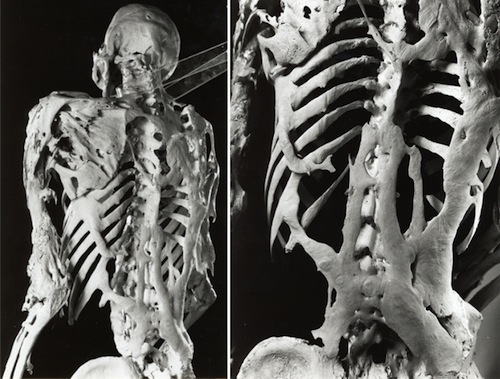|
|
Fibro-dysplasia Ossificans Progressiva, also known as Stone-Man Syndrome or FOP, is a serious condition which ruins lives. FOP is very rare - occurring only in 1 in 2,000,000 people. Only eight-hundred cases of FOP have been confirmed worldwide, two-hundred and eighty-seven of which are in the USA. FOP is a genetic disease and it's not contagious. A gene in your body called AVCR1 gene is responsible for controlling the growth in bone, cartilage and muscle tissue. When you are growing, this gene regulates the amount of bone, muscle and cartilage tissue in your body. However, a person with FOP has a mutated AVCR1 gene, meaning that the directions it gives to the body are incorrect. This leads to joints fusing and an overgrowth of bone and cartilage tissue.

The first signs of FOP occur in babies. They are born with shorter big toes which are malformed because one of the joints in the big toe is missing. In later years, tumor-like growths may be found, which are often mistaken for cancer and surgically removed. This causes a flare-up and the body's repair mechanisms 'repair' the damaged area with bone. Things like falling over, viral infections and over-exercising can also cause flare-ups. These flare-ups are often extremely painful. The bone growth general starts at the neck and progresses downwards, to the torso and lower limbs.

Gradually, throughout the FOP patient's lifespan, their body becomes completely ossified. Most people with FOP are expected to live well into adulthood, but in later life, breathing can become difficult. All the sheets and plates of bone mean that the chest cavity is smaller. The lungs have less room to expand and the person who has FOP cannot take big, deep breaths. They would take short, quick breaths to make sure they get enough oxygen. FOP basically means that the body's fibrous tissues (muscles, connective tissues, ligaments, etc) turn to bone.
People with FOP are often limited in things. For example, if their neck area has experienced bone growth, reaching things higher than the head is extremely difficult. If arms are ossified, writing is nigh on impossible. Parents living with children with FOP are given advice on how to make their child?s life easier. Floors are laid with extra padding (made from the same material as football pitches - Astroturf) and soft carpets to minimize damage if the child with FOP should fall. Light switches are put at hip-height so that they can be used from a wheelchair and furniture has cushioned corners. Handrails are often found inside the home of an FOP person to aid them if they should lose their balance.
Unfortunately, there is no cure for FOP - yet. Now that the gene that causes FOP has been found, there is hope for people suffering from FOP all over the world. A cure is not impossible and finding the FOP gene also enhanced biology studies of bone and bone structure. Learning more about FOP is likely to help us learn more about other bone-related diseases, such as osteoporosis.
Author's Note: Sources: http://www.iofbonehealth.org/fibrodysplasia-ossificans-progressiva-fop
http://www.ifopa.org/what-is-fop/overview.html
|